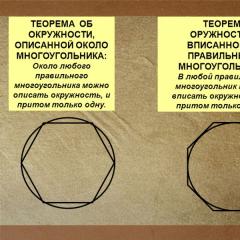Hya is a linear function. Gia linear function Correspondence between functions and gia graphs
Linear function
The tutor's experience shows that the graphs of functions, even the simplest ones, are one of the most poorly understood topics. Which, of course, is connected not so much with its complexity as with the lack of a systematic study of this topic at school. Very little time is devoted to the construction and, especially, the analysis of graphs. In addition, the study of the graphs of different functions is scattered over the years, and there is no exhaustive, collected in one place description and comparison of all the studied functions with their graphs.
A good tutor will start explaining this topic by drawing up a pivot table: general formula view, function name, graph. The most important thing is to clearly show how the appearance of a function changes with a change in its parameters.
Let's try this with a linear function:
Formula: y = kx + b, where k and b are numbers that can be both positive and negative, and equal to zero, and at and X- letters, of course. Such a function is called linear, and its graph is a straight line.
k- is called the slope and is responsible for the slope of the straight line. The figure shows graphs of two linear functions, one with a coefficient k= 2, and the other with k= 1/2. The first one increases with a greater speed, that is, it goes steeper, and the other - more gently.
If k< 0, то функция будет убывать, причем, чем больше k modulo, the steeper the graph will go down.

So, by the appearance of the graph, we can determine the sign k, and compare it modulo.
Now let's figure out how the parameter affects b on the appearance of a linear function. This makes it even easier. b is the ordinate of the point of intersection of the straight line with the axis at.
This figure shows three straight lines with the same coefficients k= 1, but they have b takes on different meanings. These values are the same as the marks on the axis at.

If k= 0, then the function will take the form y = b... for instance at= 5 or at= - 4

If b= 0, then the function will take the form y = kx... for instance y = 3x or y = - 2x.

Thus, all of the above can be summarized and brought into one table:

Another useful skill is determining the approximate value k on schedule. This is also possible. Sometimes it is necessary to know, at least approximately, the value of the slope in order to choose which formula corresponds to which graph, if the signs k in both cases are the same.
For example, a graph is given:

Let us choose two integer points on the line, if possible.
We will always move from left to right. And measure how much we move along the axis X(it will be X) and along the axis at(it will be Have)

Then divide Have on the X:
k = Y / X = - 3/ 6 = - 0,5
Note that X is always positive, and Y can be either positive or negative. In our case, when moving from the left point to the right, we shifted 3 cells down, so Y = - 3.
Let's take another example:

In this case: k = Y / X = 8/4 = 2
Now we can decide task offered in one of the options GIA 2014:
Establish correspondence between functions and their schedules:
Functions:
A) y = 2x + 6 B) y = - 2x - 6 V) y = - 2x +6
Charts:
Solution:
for x = 1,, (x, y) = (1,1) - A
at x = 1,, (x, y) = (1,0,5) - B
for x = 1,, (x, y) = (1,2) - B
Answer:
| A | B | V |
| 1 | 3 | 2 |
Demonstration version The main state examination of the OGE 2016 - task No. 5
Establish a correspondence between the graphs of functions and the formulas that define them. Write the corresponding number under each letter in the table in the answer.

1) 2x = 2 * 1 = 2, (1;2) 2x = 2 * 0 = 0 (0;0) -B
2) -2x = -2 * 1 = -2, (1;-2)
3) x + 2 = 1 + 2 = 3, (1;3) x + 2 = 0 + 2 = 2 (0;2) -A
4) y = 2; (n; 2)- B
Answer:
| A | B | V |
| 3 | 1 | 4 |
Demonstration version The main state examination of the OGE 2015 - task No. 5
Establish a correspondence between the graphs of functions and the formulas that define them.

for x = 1, y = -2 / 1 = -2, (x, y) = (1, -2) - 1
for x = 1, y = 2/1 = 2, (x, y) = (1,2) - 4
for x = 1, y = 1/2 * 1, (x, y) = (1,0.5) - 2
Answer:
| A | B | V |
| 1 | 4 | 2 |
Establish a correspondence between the schedule and the statement that is correct for it.
A) y= 3 x y = 3x
1) 


Establish a correspondence between the graphs of functions and the formulas that define them.
Write down the numbers that correspond to the graphs.
| A | B | V |
A) 3 - hyperbole. In 2nd and 4th... Substituting x = 1, we get at= dot (1,) , lies on the graph A
B) 1 - hyperbole. V 1st and 3rd... Substituting x = 3, we get y = 3, dot (3,3) lies on the chart B
C) 2 - hyperbole. In 2nd and 4th... Substituting x = 3, we get y = -3, dot (3,-3) lies on the chart V
Answer:
| A | B | V |
| 3 | 1 | 2 |
The figures show graphs of functions of the form у = kx + b. Establish a correspondence between the graphs of functions and the signs of the coefficients k and b.
1) k> 0 , b> 0 k> 0, b> 0
3) k< 0 , b< 0 k<0,b<0
Write down the numbers that correspond to the graphs.
Solution:Coefficient v is responsible for crossing the graph with OU, To- for a prick of an inclination, b> 0- the graph crosses OU above 0 ; v<0 - below; k> 0- the angle of inclination is less 90 about; To<0 - more 90 about
A) Intersection with OU above 0 : b> 0, the angle of inclination is greater 90 about: To<0 . 2
B) Intersection with OU below 0 : v<0 , the angle of inclination is greater 90 about: To<0 . 3
C) Intersection with OU above 0 : b> 0, the angle of inclination is greater 90 about: k> 0. 1
Answer:
| A | B | V |
| 2 | 3 | 1 |
Establish a correspondence between the graphs of functions and the formulas that define them.
1) y = - x - 2
2) y = (x + 1) 2
4) y = (x - 1) 2
Write down the numbers that correspond to the graphs.
Solution:A) 4 - judging by the direction of the parabola y = a (x-x o) + y o.
B) 3 - recumbent semi-parabola.
B) 1 - straight line (given by linear functions).
Answer:
| A | B | V |
| 4 | 3 | 1 |
Establish correspondence between functions and their schedules.
Functions: A) ![]() B)
B) ![]() V)
V) ![]()
Charts:
In the table, under each letter, indicate the corresponding number.
Solution:All graph equations are parabolas. Recall that if the sign in front is positive, then the branches of the parabola are directed upward, otherwise downward.
A) the branches of the parabola are directed upward, point ![]() this corresponds to graph number 1;
this corresponds to graph number 1;
B) the branches are directed downward and only one chart at number 3 corresponds to this;
B) the branches are directed upward with a point ![]() which corresponds to the graph at number 2.
which corresponds to the graph at number 2.
The figure shows how the air temperature changed from $ 4 to $ 6 in September. The time of day is shown horizontally, while the vertical is the temperature value in degrees Celsius. Find pa ...
Task 5 from the OGE in mathematics is included in the algebraic module. It allows you to assess the ability to analyze graphs, find the necessary information in them. Concrete examples, clarity make it easier to complete - even those who have difficulty with abstract calculations can easily cope with the fifth task.
This is one of the variants of "real math". Everyone in life has to deal with charts, the skill of reading such pictures will certainly come in handy in the future. Graphic images complement many analytical articles and educational publications, help to better assimilate the material, quickly grasp the essence of problems, and identify achievements. By the ninth grade of high school, students often have experience in analysis and even charting, so the test will be easy to master. A ninth-grader gets one point for the correct answer. We remind you that the "Algebra" module includes only 11 tasks; to get a satisfactory grade, you will have to correctly complete at least three of them.
Universal algorithm
Tasks of this type represent a graph with explanations - which data is indicated on one axis, and which on the other. In the image, you can find the answers to all questions. The algorithm is simple: you need to find a point on one axis (the same condition mentioned in the question), draw a straight line to the graph, look at the value on the other. Be sure to read the question carefully so you don't miss important clarifications.
Questions may vary depending on the condition. Usually you need to find out what the coordinate on the x-axis will be at a certain value on the y-axis, or vice versa. You may also need to calculate how the data changes in the interval indicated in the question.
To get the right solution, you should proceed as follows:
- Examine the condition.
- Relate what is written to the drawing.
- Read the question.
- Take into account the circumstances indicated in it.
- Find the desired coordinate on one axis.
- Draw a straight line to the intersection with the graph.
- Measure from this point a straight line to the second axis.
- Mark the received number in the draft.
- If this is the answer to the question, double-check and write it down.
- If you need to get other data, proceed in the same way.
- Make the necessary calculations using the found and indicated numbers, check, write down the result.
All these actions will take no more than 2 - 3 minutes. Good luck!


